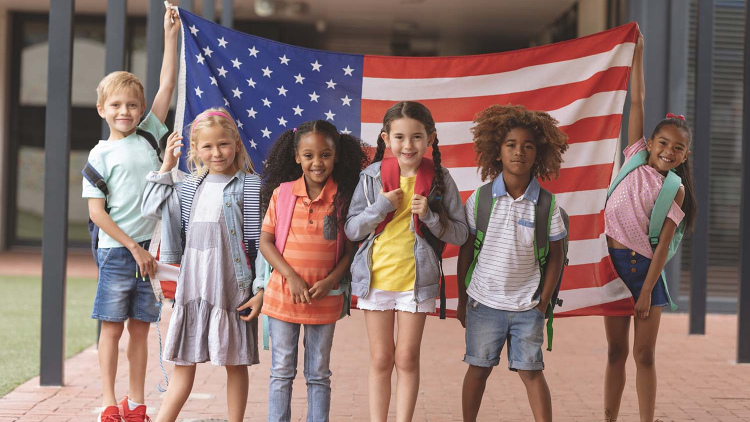Understanding Creativity
- Posted June 25, 2020
- By Emily Boudreau

Understanding the learning that happens with creative work can often be elusive in any K–12 subject. A new study from Harvard Graduate School of Education Associate Professor Karen Brennan , and researchers Paulina Haduong and Emily Veno, compiles case studies, interviews, and assessment artifacts from 80 computer science teachers across the K–12 space. These data shed new light on how teachers tackle this challenge in an emerging subject area.
“A common refrain we were hearing from teachers was, ‘We’re really excited about doing creative work in the classroom but we’re uncertain about how to assess what kids are learning, and that makes it hard for us to do what we want to do,’” Brennan says. “We wanted to learn from teachers who are supporting and assessing creativity in the classroom, and amplify their work, and celebrate it and show what’s possible as a way of helping other teachers.”

Create a culture that values meaningful assessment for learning — not just grades
As many schools and districts decided to suspend letter grades during the pandemic, teachers need to help students find intrinsic motivation. “It’s a great moment to ask, ‘What would assessment look like without a focus on grades and competition?’” says Veno.
Indeed, the practice of fostering a classroom culture that celebrates student voice, creativity, and exploration isn’t limited to computer science. The practice of being a creative agent in the world extends through all subject areas.
The research team suggests the following principles from computer science classrooms may help shape assessment culture across grade levels and subject areas.
Solicit different kinds of feedback
Give students the time and space to receive and incorporate feedback. “One thing that’s been highlighted in assessment work is that it is not about the teacher talking to a student in a vacuum,” says Haduong, noting that hearing from peers and outside audience members can help students find meaning and direction as they move forward with their projects.
- Feedback rubrics help students receive targeted feedback from audience members. Additionally, looking at the rubrics can help the teacher gather data on student work.
Emphasize the process for teachers and students
Finding the appropriate rubric or creating effective project scaffolding is a journey. Indeed, according to Haduong, “we found that many educators had a deep commitment to iteration in their own work.” Successful assessment practices conveyed that spirit to students.
- Keeping design journals can help students see their work as it progresses and provides documentation for teachers on the student’s process.
- Consider the message sent by the form and aesthetics of rubrics. One educator decided to use a handwritten assessment to convey that teachers, too, are working on refining their practice.
Scaffold independence
Students need to be able to take ownership of their learning as virtual learning lessens teacher oversight. Students need to look at their own work critically and know when they’ve done their best. Teachers need to guide students in this process and provide scaffolded opportunities for reflection.
- Have students design their own assessment rubric. Students then develop their own continuum to help independently set expectations for themselves and their work.
Key Takeaways
- Assessment shouldn’t be limited to the grade a student receives at the end of the semester or a final exam. Rather, it should be part of the classroom culture and it should be continuous, with an emphasis on using assessment not for accountability or extrinsic motivation, but to support student learning.
- Teachers can help learners see that learning and teaching are iterative processes by being more transparent about their own efforts to reflect and iterate on their practices.
- Teachers should scaffold opportunities for students to evaluate their own work and develop independence.
Additional Resources
- Creative Computing curriculum and projects
- Karen Brennan on helping kids get “unstuck”
- Usable Knowledge on how assessment can help continue the learning process

Usable Knowledge
Connecting education research to practice — with timely insights for educators, families, and communities
Related Articles

Strategies for Leveling the Educational Playing Field
New research on SAT/ACT test scores reveals stark inequalities in academic achievement based on wealth

What Impact Have High School Exit Exams Had in Massachusetts?
A new report investigates whether high-stakes graduation tests improve student achievement and long-term success

What Students Need to Learn to Become Skilled Citizens
Active citizenship requires a broad set of skills, new study finds
- Hispanoamérica
- Work at ArchDaily
- Terms of Use
- Privacy Policy
- Cookie Policy
Major Lessons of Contemporary School Design: 37 Learning Spaces from Around the World

- Written by James Wormald
- Published on November 15, 2023
The role of a school is to prepare children for life. But with life-changing faster than ever, schools need to change just as quickly. Recent additions to school curriculums reflect the complexities of modern life, with environmental crises, societal injustices, and the dangers of social media now major parts of the syllabus.
Although it’s often said that long-term change begins at ground-level, change is never easy, wherever it starts. For example, a curriculum that responds to environmental issues is said to cause growing instances of eco-anxiety in children , one of a number of causes of another crisis , in children’s mental health.

As what we educate children changes, educational environments change too. Not just with low-carbon buildings and outdoor teaching demonstrating sustainability, but with modern spaces that teach children how to navigate climate, social, and inclusivity issues, while also caring for themselves and their own mental health by learning how to talk, and listen, to others.
"Be True To Yourself" in a Private Space of One’s Own: Lockers
People, especially impressionable young people, should be taught they do not need to change as much as society seems to suggest. But honesty with oneself is hard when you don’t yet know who you are. Fear of not fitting in is one of the more traditional causes of school anxiety and forces children to wear many different hats throughout the day. Which can be psychologically exhausting. Private storage spaces like lockers allow students to keep personal objects nearby, thus creating a safe, comfortable space to return to. At Hello School in Dnipro, Ukraine, for example, large personal lockers and desks with personal storage compartments are part of the school’s commitment to providing comfortable, private environments for children.
Hello School Interiors / SVOYA Studio

Lycée Bel Val / Atelier d’Architecture et de Design Jim Clemes

Saint George's College Classrooms, Courtyards and Corridors Renovations / Elton&Deves

Arabista Ribera School / Victor García Martínez

The East Harlem School / GLUCK+

The Future Is Secure: Softening the Hard Edge of School Security
As the number of school shootings continues to rise , school security is as big a part of education environments as ever, with some teachers in the US now mandated to lock their classrooms during class, despite the resulting effect on fire safety . Some, like Lisle Elementary School in Illinois, US, provide hidden student safety features such as security camera surveillance, along with exterior and interior doors that lock simultaneously during a lockdown. While the Animo South Los Angeles High School in LA, US, which was rebuilt after a fire, keeps the school setting both fun and safe, surrounding it with a 20-foot-hight bulletproof aluminum fence that ‘sparkles in the sun and glows at night,’ share the architects Brooks + Scarpa.
Lisle Elementary School / Perkins and Will

Animo South Los Angeles High School / BROOKS + SCARPA

Moulon Group of Schools / Dominique Coulon & associés

Back of the Yards High School / STL Architects

Creating Positivity and Pride with School Spirit
Bullet-proof fences and security camera networks can improve student safety, but can instead spread the uncomfortable feeling of fear. By using a palette of identifiable color schemes, design motifs, and logos, however, a strong school spirit changes the atmosphere to become more positive and joyful. The Menlo School MAC in Atherton, California, US, for example, flanks its school’s sports gymnasium with retractable bleacher seats and positions a hall of fame trophy cabinet overlooking the arena for the entire school to share its success. UDEM high school’s Maker Space Building in San Pedro Garza García, Mexico, meanwhile, proves success is not just measured in sporting achievement, with perimeter-set shelving showcasing students’ produced objects inside and out.
Menlo School MAC / Kevin Hart Architecture

Maker Space Building / Garza Camisay arquitectos

Renovation of the Primary School Affiliated to Longjiang Foreign Language School / Atelier cnS

Riverbank High School / Darden Architects

Using Learning Spaces to Serve the Community
By adding audience seating to school sports team gymnasiums, schools can invite and share their success with the community, spreading positivity to the local high street, as well as school corridors. But as schools are only used for part of the week, by opening up their common areas, they can help the local community more directly. The Community Canvas School in Sawarpada, India, for example, allows its circular central courtyard to be used for community activities such as political campaigns, performances, and temporary health care. Whereas the Copenhagen International School in Denmark closes off classrooms for common areas like the canteen, library, and performance facilities, keeping them open for community events outside school hours.
Community Canvas School / pk_iNCEPTiON


Copenhagen International School Nordhavn / C.F. Møller

Reggio School / Andrés Jaque / Office for Political Innovation

Porto Potenza Picena Primary School / Settanta7

Aspen Community School / Studio B Architecture + Interiors

Educational Social Spaces
Schools teach more than just maths, languages, and science. They’re also where children learn about life: how to talk to one another with empathy, learn from each other with grace, ask for help with humility, and listen with understanding. In short, schools teach how to be a good friend. It’s imperative, therefore, that they provide both the environments and opportunities for children to learn social skills, by being social.
With many resources now available online, the Stevenson School Library in Del Monte Forest, California, US, found they had an abundance of unused space, so transformed the once quiet library into a multi-use presentation, collaboration, and social space. While Victoria Park Academy in Shenzhen, China, has an area of the school dedicated to social networking, and a timetable with ten minutes of the social recess between each class.
Stevenson School Library / Studio O+A

Victoria Park Academy / Atelier Global

Children's Campus Theodoor / cuypers & Q architecten

Billie Holiday School Complex / BPM Architectes

SISB School Thonburi Phase II / Plan Architect

Adaptable: Ready for an Unknown Future
Designing a school with laptop-friendly power sockets in every desk, or even a designated Twitter area, as Victoria Park Academy has, seems like a sensible way to future-product classrooms from the digital path we’re on. But those design considerations are responses to the educational environment we can see already changing around us. What about the more urgent future events we find harder to predict?
Whether we look to examples like Mount Si High School in Washington State, US, which is raised above-ground to protect from flood waters due to its valley location, Reeds Spring Middle School’s tornado-proof, vegetated roof in Missouri, US, or Santa Monica High School’s adaptable classrooms in Malibu, California, US, designed and prepared for the building’s adaptive reuse from the outset, education spaces that consider the uncertain certainties of future events are those that will last the longest.
Mount Si High School / NAC Architecture

Reeds Spring Middle School / Dake Wells Architecture

Santa Monica High School Discovery Building / HED + Moore Ruble Yudell

Desiderata Alternative High School / Jones Studio

Curro Durbanville Highschool / BPAS Architects

Learning to Utilize and Conserve Outdoor Spaces
There’s been a huge shift towards biophilic workplaces in the last decade or so. Well before the pandemic we started to realize how important it s for employee well-being to have regular access to green, outdoor space throughout the working day. Schools meanwhile, essentially workplaces for children, are no different. By positioning its collected buildings around a green-topped playground space, the Kincang Modern Pre-School in Shaoxing, China, allows children to playfully discover the natural world in the center of a very urban environment, enclosed and protected from the city. The Belvue School in London, UK, meanwhile, utilized its location aside from woodland by installing two rooms to sit on the edge of the spinney and house unique facilities which allow environmental learning.
Kincang Modern Pre-School / LYCS Architecture

Woodland Classrooms Belvue School / Studio Weave

Farm Kindergarten Rheinhof / MWArchitekten

Quzhou Xinhua No. 2 Primary School / LYCS Architecture

Environmental Classroom UES / Plan:b arquitectos

Alternative Learning: Collaborative Space
As well as biophilic design, using other contemporary design techniques to create more comfortable, productive, and empathetic workplaces has an obvious correlation with learning space too. Education systems have failed children in the past by assuming everyone learns in the same way – sitting quietly and reading from a blackboard or textbook. Research in educational psychology , however, tells us that providing alternative types of learning improves both the student experience and the results. The Yokohama International School, in Japan, for example, includes diverse ‘open hubs’ that connect classrooms and facilitate collaborative group work, while the John S. McCain III Elementary School in Buckeye, Arizona, US, features environments with multi-dimensional infrastructure, reaching a high degree of flexibility, variety, and collaborative opportunities.
Yokohama International School / TAISEI DESIGN Planners Architects & Engineers + Kengo Kuma & Associates

John S. McCain III Elementary School / Orcutt | Winslow

Kindergarten in Saint-Ouen-Du-Tilleul / ACAU Architectes

Prototype for UDEM Polytechnic / Bernardo Hinojosa

Find these Contemporary School Design projects in this My ArchDaily folder created by the author.
Image gallery

- Sustainability
想阅读文章的中文版本吗?

当代校园设计的主要启示:来自世界各地的37个学习空间
You've started following your first account, did you know.
You'll now receive updates based on what you follow! Personalize your stream and start following your favorite authors, offices and users.

IMAGES
COMMENTS
Understanding Creativity. New research provides insight for educators into how to effectively assess creative work in K-12 classrooms. Posted June 25, 2020. By Emily Boudreau. Understanding the learning that happens with creative work can often be elusive in any K–12 subject.
Not just with low-carbon buildings and outdoor teaching demonstrating sustainability, but with modern spaces that teach children how to navigate climate, social, and inclusivity issues, while...
Creativity In Instructional Design From The Lens Of Experts In The Field. Developing creativity has become a relevant topic in the field of education; it is becoming more accepted that real learning extends beyond the retention of declarative content (Hokanson 2016).
Recently, an increasing number of countries have emphasized creativity in their official curricula. However, the journey from openly acknowledging the importance of creativity to systematically and purposefully supporting its promotion in the classroom is a long one.
Creative education is sometimes called design education but that may be confused with education pertaining to the design industry (i.e. architecture, graphic design, interior design, etc.). Design thinking also explains the process of creatively solving problems in all faucets of life.
With these 19 easy classroom ideas and ready-to-go design templates, you can encourage your students to explore their creativity throughout the school year. You’ll soon see sparks of inspiration flashing all around the classroom!